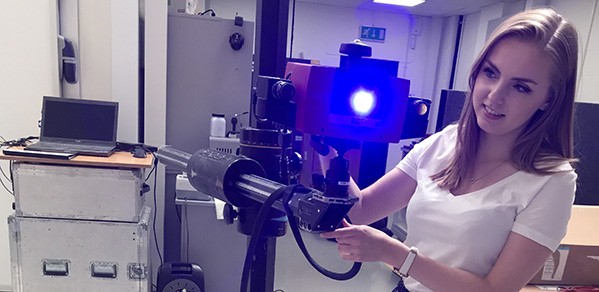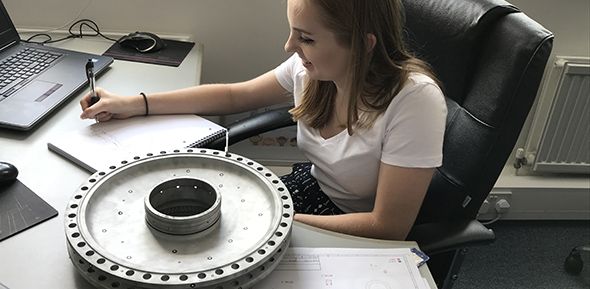
Courtney Collins is in the third year of her Master of Engineering degree (MEng) and gained hands-on engineering experience at Physical Digital as part of an internship.
My time at Physical Digital has been immensely helpful. I’m very grateful to the team for taking the time to broaden my understanding of 3D structured light scanning for metrology and for giving me the opportunity to get hands-on experience in an area of engineering of which I had no prior knowledge. I’m looking forward to utilising all the new skills I've learned.
Undergraduate Courtney Collins
Courtney shares her internship diary entries, written in her own words, that detail all that she learned about 3D optical measurement.
Week one
This is my first experience working in an engineering-focused workplace. I’m sat in the Physical Digital office, approaching the end of my first week, and excited at the prospect of spending another eight weeks with the team.
On Monday morning I was thrown right into training. Dan, the engineering manager here, gave me an introduction into photogrammetry and let me get involved right away. I hardly sat down the entire day and absorbed more information than I thought I would all week! On Tuesday, I revised all this information by (almost independently) setting up and scanning a household fan, and I started to learn how to use the programme GOM Inspect in more detail. Wednesday was my first opportunity to get involved with a real project, working on the scanning and inspection of a metal component, and I now realise just how much detail and precision is needed for even the smallest of components.
I’ve been surprised at just how much is going on around me. There are such a wide range of projects in progress all at the same time. From aircraft engine components to medical engineering equipment, there are endless things to pique my interest and I can’t wait to get involved in all sorts of exciting projects during my time at Physical Digital.
Week two
I started out the week working on my individual project, inspecting a disc out of a historic jet engine to be used by the company as a verification artefact. This involved me learning how to use Siemens NX in order to create a casting model of the part. This proved difficult as I wasn’t able to get any reliable measurements by hand, so it will be interesting to see how the scan data compares to my estimates.
I’ve continued work on the client project this week and I’m beginning to understand some of the challenges you are presented with when scanning such small and intricate parts. One of the most essential things I’ve learned is how to ensure data is not lost from where it is held into place. For such tiny parts, this can be quite tricky. The team showed me how to overcome this and ensure complete accuracy, but it highlighted how the process for different parts can vary depending on size and complexity.
I also had the opportunity to exercise my photogrammetry knowledge again, this time on a much larger scale as I got to scan a custom motorbike. This was a bit of a challenge as some of the surfaces were very shiny, but I managed to complete the photogrammetry, with it computing first time.
On Thursday and Friday, I went out on my first site visits to two automotive design studios. They were both to scan clay models of cars. It was beneficial for me to experience the same process on both visits, as it allowed me to become familiar with the set-up and the process of taking the photogrammetry, calibrating and capturing data with the 3D scanner, as well as aligning and processing the data. This meant I could get more involved when out on site on the Friday. It was really exciting to be able to visit these leading automotive companies despite the very early morning starts for a student!

Courtney worked on the scanning and inspection of a metal component. Credit: Physical Digital Ltd
Week three and four
The past two weeks have been very busy. I’ve been involved in various projects which highlight just how many areas of engineering and manufacturing Physical Digital influence. I’ve been getting involved with reverse engineering and I produced a CAD model of a powertrain component using Siemens NX. I had to get used to the way Siemens NX works as well as learning about some additional features it provides. What this task has taught me is to always think about how a component is manufactured from start to finish, and to follow the same steps when building a model of the component. It’s definitely inspired me to pursue any manufacturing and materials courses I can at University in the coming years.
This week, I was able to consolidate all the skills I learned from visiting automotive design studios, meaning I’m now quite confident in the process that is undertaken when customers require an aligned 3D mesh model of a component or product. I was also given the opportunity to visit a factory that manufactures satellite dishes and see how photogrammetry is used to capture the dish and identify areas of height deviation across each petal of the dish. It was interesting to see how the large variation of height was caused by the adjustments made, and the very small tolerances that we were able to achieve.
I had my first meeting with a client to finish the component project I’ve been working on in previous weeks. This gave me a greater insight into the context for inspecting the part and allowed us to discuss our findings. I was then able to produce a final trend report, export mesh files and produce statistics of each part as requested by the client. This was a great opportunity for me to experience a project from start to finish. I saw how the whole process of 3D scanning and measurement is orientated to the requirements of the client and how Physical Digital deliver this.
Week five and six
- Heat transfer project
- Car benchmarking
- Create casting model for verification artefact
- 5X scanning of verification artefact
For the last two weeks, I’ve had the opportunity to work on a small project that involved investigating the process of heat soaking before the 3D measurement process begins. Standard practice is to leave any component for 24 hours at 20°C – this is the international measurement temperature. This project is to justify this claim by analysing the heat transfer process. It required me to look back at my university notes and look ahead to a module that I will be studying next year when I specialise in Aerothermal Engineering. There were many variables that I needed to consider, such as the material properties, geometry of the component, the possible temperature gradients across the component and properties of the air in the scan room. I was able to compile a process to estimate the maximum length of time the component needed to be kept at 20°C for, for it to be within measurement tolerance.
I’ve been continuing with my verification artefact project by repeating the photogrammetry and scan process multiple times to produce a trend report. This is important, as the very small variations in the scan data proves that our systems are very repeatable and that we can produce very low tolerances for the whole data capture process. During this project, I produced a CAD model by reverse engineering the artefact and then creating a casting tool that it could be manufactured to produce multiple parts.
Week seven, eight and nine
I've been learning how to use Spaceclaim, a different piece of CAD software, which is a useful tool for visualising parts and creating simple components.
I managed to build a clamp for a component with a complex 3D structure within this software and learned how to set it up for 3D printing, something that I haven’t attempted independently before. It’s interesting to see how accurately the printer can produce your component and what you need to consider before the design is ready to print, such as a larger radius, tolerances and making any holes slightly larger and further away from the edges in order to avoid cracking. Now that I have these skills, I'm looking forward to being able to use them in other applications at University.
I’ve also had the opportunity to scan and inspect an automotive engine component ready for our design engineers to reverse engineer it. This has been good practice reading the very complicated drawings.
In summary
My time at Physical Digital has been immensely helpful. I’m very grateful to the team for taking the time to broaden my understanding of 3D structured light scanning for metrology and for giving me the opportunity to get hands-on experience in an area of engineering of which I had no prior knowledge. I’m looking forward to utilising all the new skills I've learned.
This article has been edited from the Physical Digital website.
The Department of Engineering runs an Industrial Placements scheme and supports current undergraduate students as they search and apply for summer internships. The Department also works closely with employers to promote vacancies and encourage applications for their internship opportunities. To find out more, email Vicky Houghton, Industrial Placements Co-ordinator, at placements-coordinator@eng.cam.ac.uk

